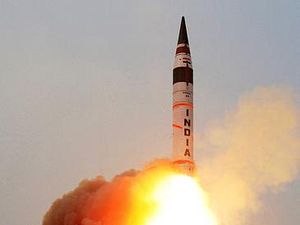India has successfully test fired its most advanced nuclear-capable intercontinental ballistic missile (ICBM), the Agni-V, the country’s defense ministry announced in statement. The missile was fired from Abdul Kalam island off the coast of the eastern Indian state of Odisha on Thursday morning.
“Long Range Surface-to-Surface Ballistic Missile, Agni-V, was successfully flight tested for its full range today at 0953 [hours] from Dr. Abdul Kalam Island, Odisha,” an Indian Ministry of Defense (MoD) statement announced. “All objectives of the mission have been successfully met. ”The successful test reaffirms India’s “indigenous missile capabilities and further strengthens our credible deterrence,” the MoD added.
The three-stage missile was fired from a canister on a road-mobile launcher. This constitutes the fifth test of the Agni-V. The ICBM was last test-fired in December 2016. The other tests occurred in 2012, 2013, and 2015.
“While two of the previous launches, taking place in April 2012 and September 2013 respectively, had the Agni-V tested in ‘open configuration,’ the January 2015 test involved the launch of ICBM from a hermetically sealed canister mounted on a mobile transporter erector launcher in so-called ‘deliverable configuration,’” I explained in December 2016.
As I noted elsewhere, the Agni-V is India’s most advanced ICBM and is meant to provide the country with a second-strike capability:
The Agni-V, a three-stage solid fueled missile, has an approximate range of 5,500-5,800 kilometers [the exact range remains classified], and can carry a 1,500-kilogram (3,300-pound) nuclear warhead. India has reportedly also been working on multiple independently targetable reentry vehicles (MIRV) for the Agni-V in order to ensure a credible second-strike capability.
India has also been working on a next-generation ICBM, the Agni-VI, a four-stage ICBM with MIRV and a maneuverable reentry vehicle (MaRV) capability. The Agni-VI purportedly can hit targets beyond the range of 10,000 kilometers.
While previous nuclear-capable missiles of the series (Agni-I, Agni-II, and Agni-III) were developed to offset Pakistan’s nuclear arsenal, the Agni-IV,Agni-V and Agni-VI, given their longer ranges, are designed to provide a credible nuclear deterrent against China.
Both the Agni-V and Agni-VI will feature increased accuracy and a reduced launch time, which, paired with India’s burgeoning MaRV and MIRV capability, can have a destabilizing effect on the overall strategic balance in the region.
Today’s pre-induction test is paving the way for user trials of the Agni-V ICBM by India’s Strategic Forces Command. India has a No First-Use (NFU) doctrine on the use of nuclear weapons, based on credible minimum deterrence, and keeps its nuclear warheads de-mated from the actual missiles.































